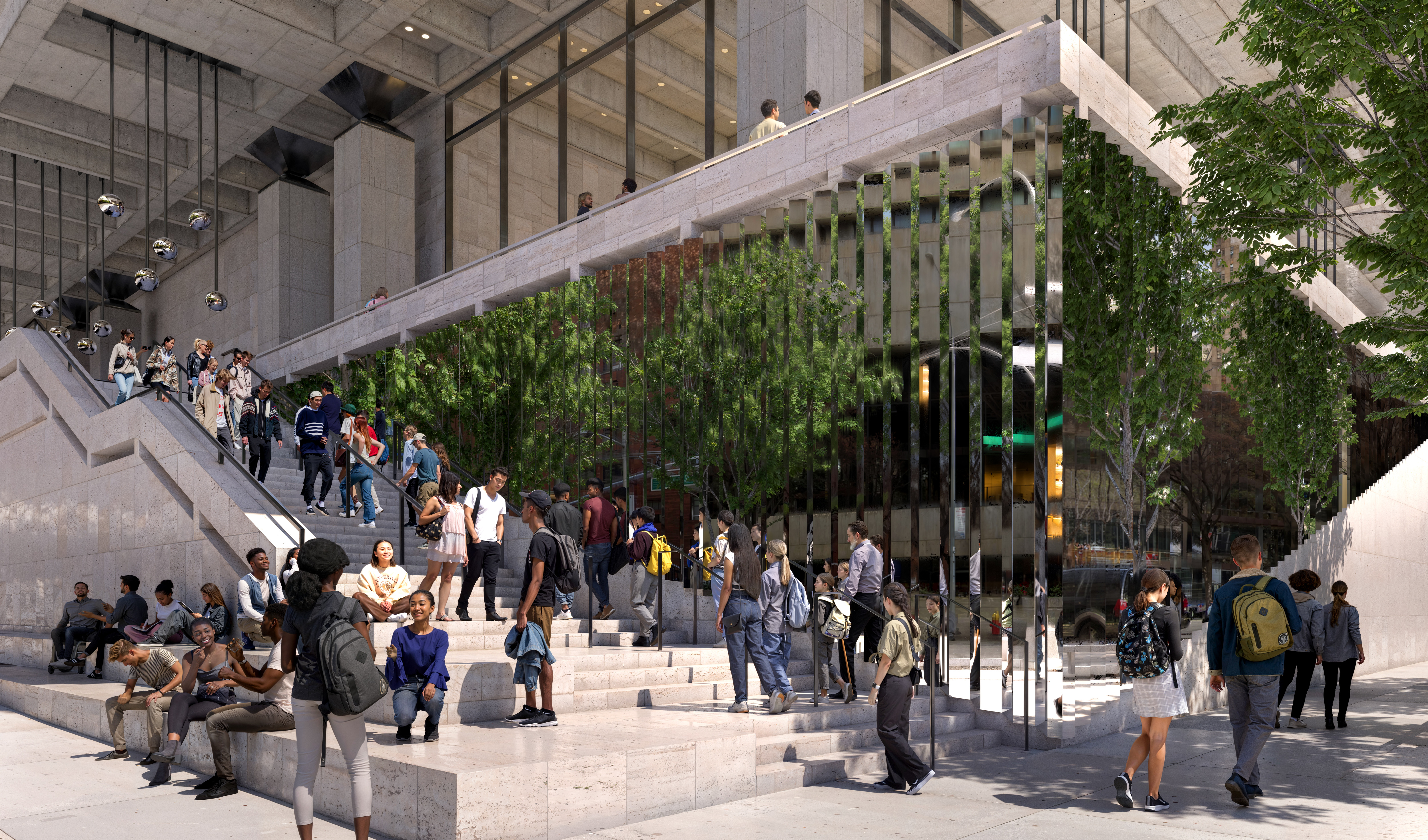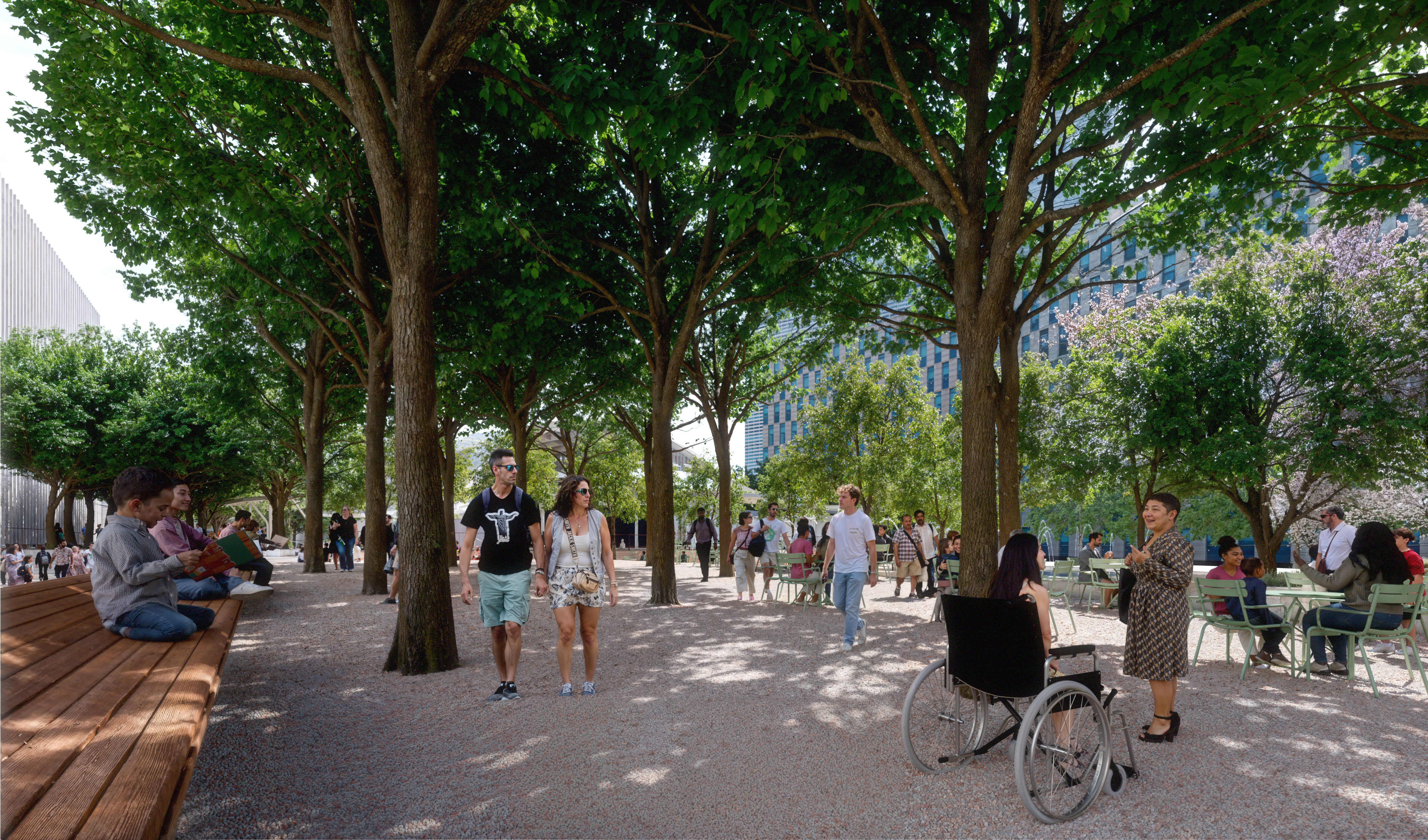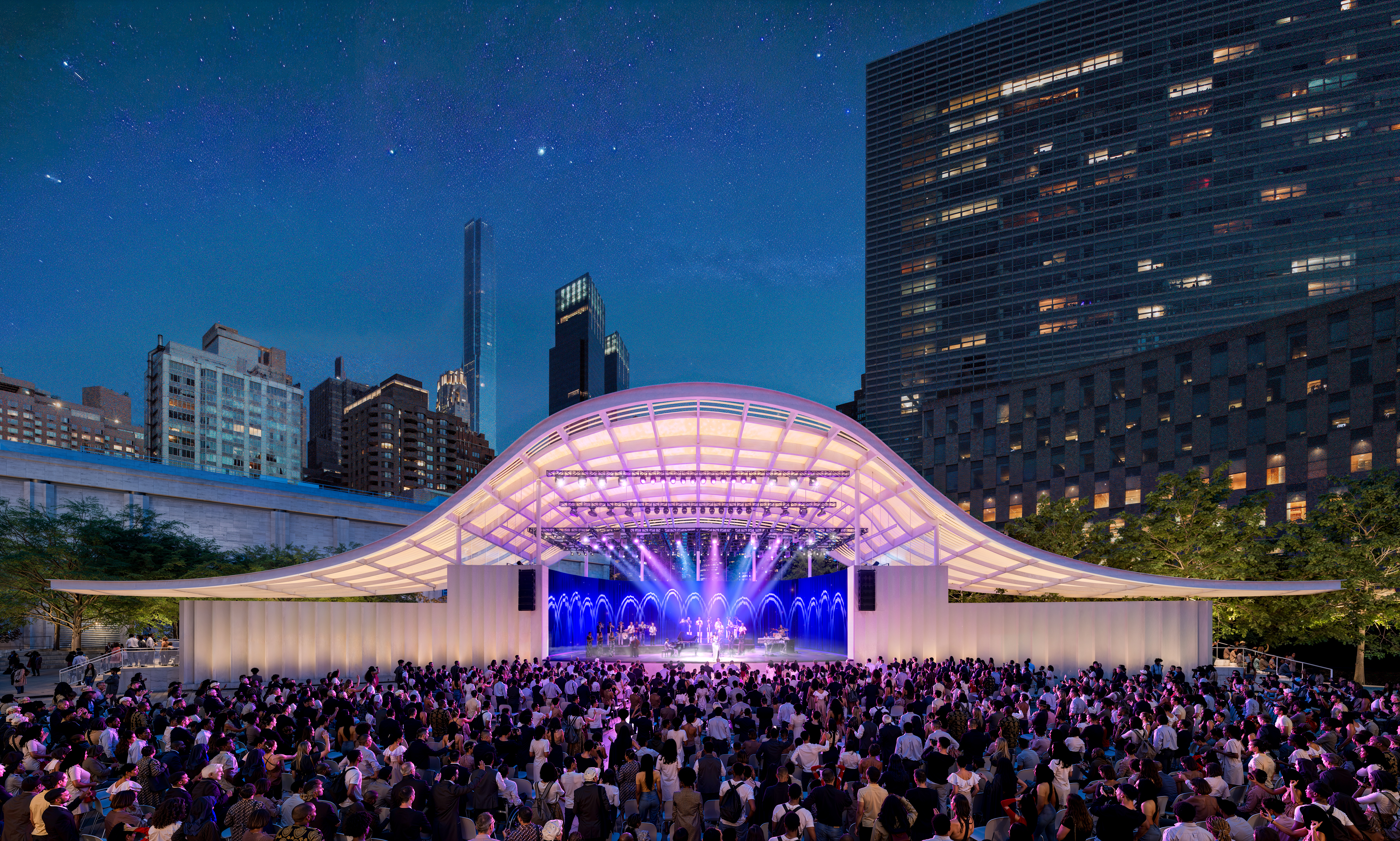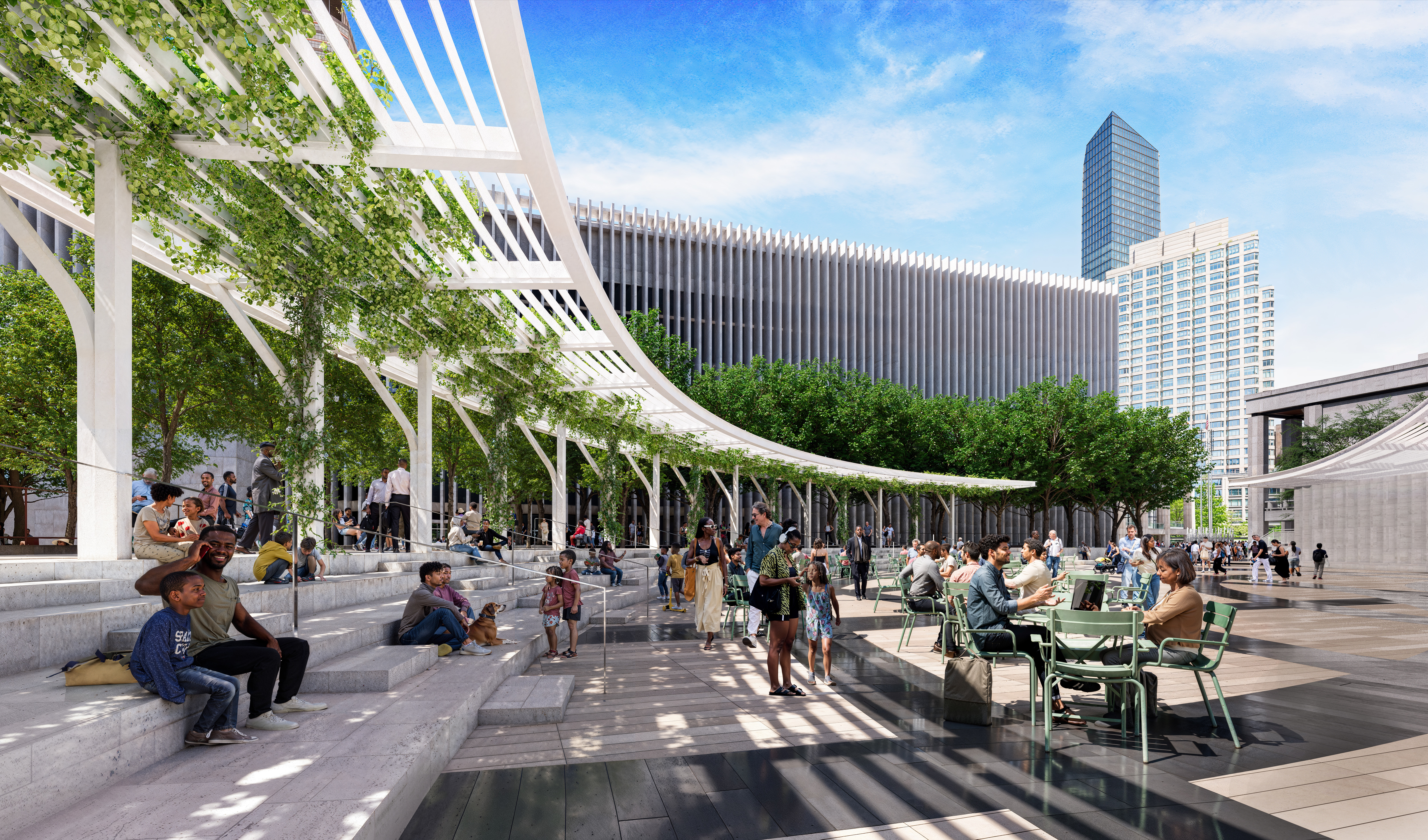Design Unveiled for West Side of Lincoln Center Campus
Removes Amsterdam Avenue Wall to Open Up
Lincoln Center with Welcoming Entrances, World Class Theater,
Vibrant Community Park, and More
Lead Gifts from the Stavros Niarchos Foundation and
The Starr Foundation Mark Bold Investment in NYC and Share the Inspiration
and Joy of the Arts with More New Yorkers
Design by Hood Design Studio, WEISS/MANFREDI, and Moody Nolan
Incorporates Feedback from Thousands of Community Members
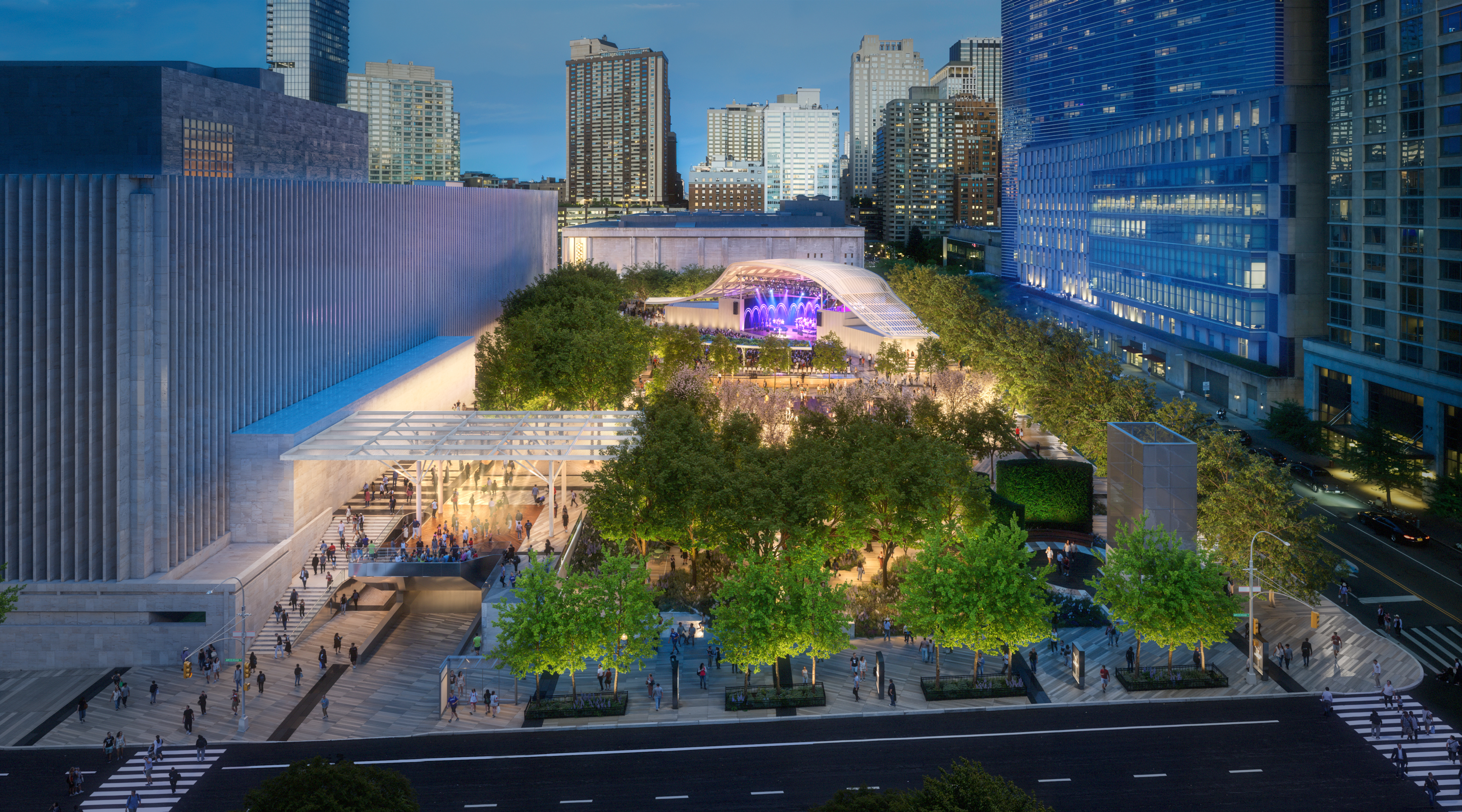
Aerial view from Amsterdam Avenue looking east; visible are a new streetscape, gardens, and theater.
Rendering by Brooklyn Digital Foundry.
New York (May 19, 2025) – Lincoln Center for the Performing Arts, Inc. (LCPA) today announced the preliminary design for the Amsterdam Avenue side of its campus. Designed by Hood Design Studio (Landscape Architect), WEISS/MANFREDI Architecture/Landscape/Urbanism (Design Architect) and Moody Nolan (Architect of Record), renderings are being released for the first time today and are available here.
The project creates a new, world-class outdoor performance venue, community park spaces, and removes the wall that has separated Lincoln Center from Amsterdam Avenue—creating new, welcoming entrances along the complex’s west side. Responding to Lincoln Center and local communities’ desire to remove this wall at Damrosch Park, it will be replaced with a series of welcoming transition spaces from the street into Lincoln Center’s iconic campus. This extends greater welcome along the west of the performing arts center, while creating a more usable and inviting public park and performance venues that better meet the needs of artists and audiences today. Key features include:
- A welcoming entrance that dramatically opens up Lincoln Center’s Amsterdam Avenue face to neighbors approaching from the west
- A community park featuring a lawn, water feature, tree groves, and garden for public enjoyment
- A new, world-class performance venue that will greatly improve artist and audience experiences
The design balances the interventions made to the east side of Lincoln Center’s campus more than a decade ago, which created more welcoming outdoor spaces on the north and east of campus needed to deliver on its founding mission of the arts for all.
The new design incorporates extensive community feedback from an ongoing participatory process that began in 2023, which engaged thousands of local neighbors, NYCHA residents, community groups, students, and New Yorkers in discussions about how the western side of the campus is used and helped shape the design.
The $335 million capital campaign to support the transformation of the west side of Lincoln Center’s campus has raised 65% to-date, including generous support from the LCPA Board of Directors, who have championed and prioritized this important work from the beginning, as well as a $10 million commitment from the State of New York.
The Stavros Niarchos Foundation (SNF) is a Founding Partner of this visionary process, with a $75 million grant that includes their initial support when the project began and builds upon their support of free programming throughout Summer for the City and the ongoing Legacies of San Juan Hill initiative.
A lead gift from The Starr Foundation provides invaluable support, anchoring the project which aligns with its longstanding support of the arts, culture, and vital New York communities.
The Stavros Niarchos Foundation (SNF) Lincoln Center West Initiative continues LCPA’s bold investments in the vibrancy of New York and helps ensure the arts are accessible to all—including the expansion of free artistic programs, the design and implementation of a Choose-What-You-Pay ticketing model, the reopening of the redesigned David Geffen Hall, and work with partners across the city—cultivating audiences’ sense of belonging through engagement with art from a range of cultural traditions. Construction is expected to begin in spring 2026 and to be completed by spring 2028.
This project is being undertaken in coordination with NYC Parks and NYC Department of Transportation. Damrosch Park is mapped city parkland maintained and operated by LCPA.
An Integrated Design for Greater Access
Opening up to Amsterdam Avenue
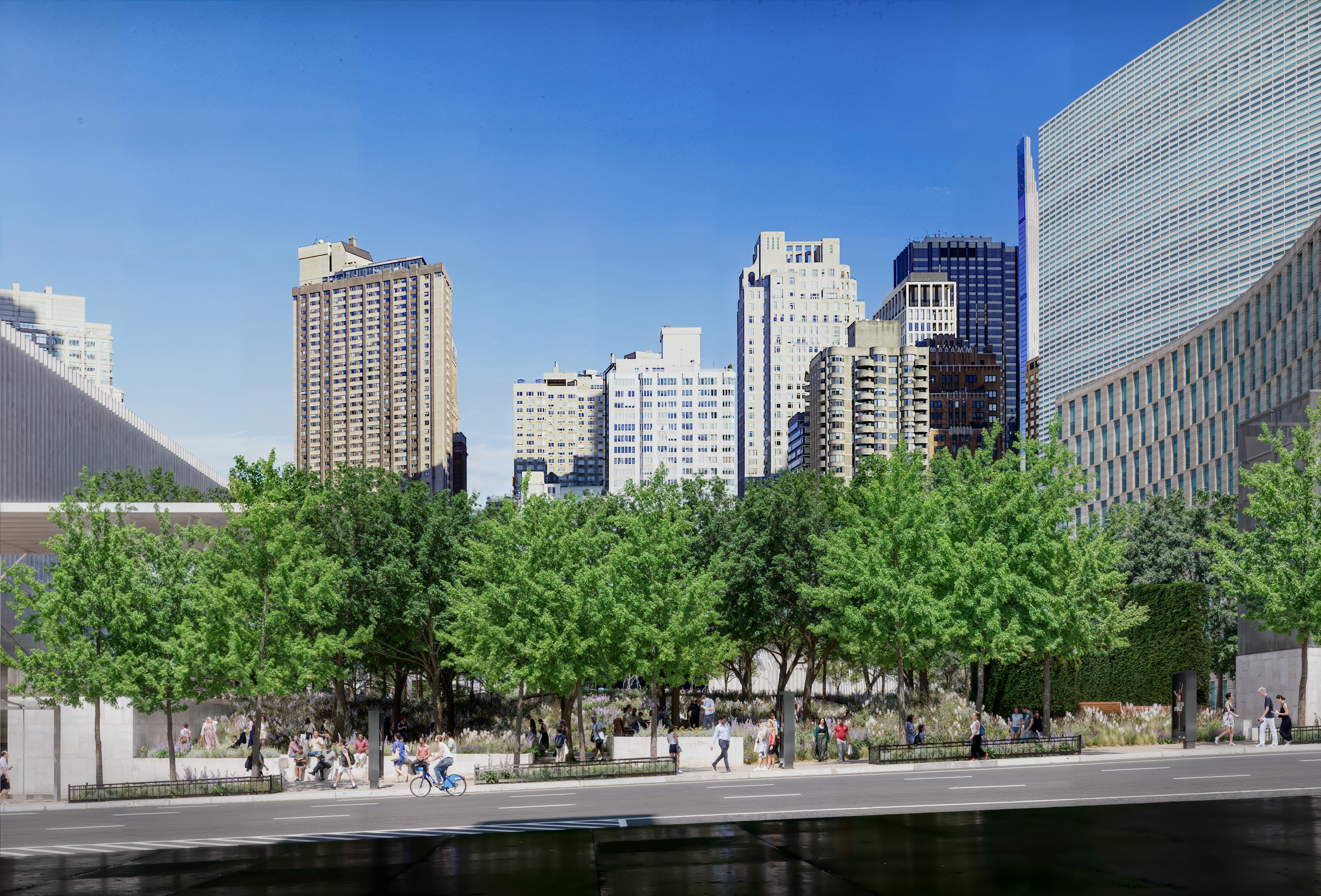
View from Amsterdam Avenue looking into Damrosch Park; visible is new streetscape.
Rendering by Brooklyn Digital Foundry.
By removing the wall at Damrosch Park and replacing it with inviting, human-scale spaces, the design— developed with input from NYC Parks— improves pedestrian circulation and prioritizes places for community use and relaxation. The design also seamlessly connects to the rest of the campus, including Josie Robertson Plaza, bringing the park to the street and introducing greater access and works of art in the park.
The new design eliminates the visual and physical barrier wall at Damrosch Park to create a more welcoming edge to the campus, to better serve close neighbors including residents of New York City Housing Authority campuses at Amsterdam Houses and Addition, students of Fiorello H. LaGuardia High School of Music & Art and Performing Arts, and the five high schools at the Martin Luther King, Jr. Educational Complex.
Drawing inspiration from Lincoln Center’s Modernist architecture and landscape architecture, the design acknowledges the original campus’ symmetrical layout and formal edges by retaining a strong central axis and formal entry points, while introducing and sensitively integrating contemporary elements that accommodate accessibility, flexibility of use, and a variety of programmatic needs. The new design also incorporates materials, textures, colors, and scale of design elements found across the rest of Lincoln Center to create cohesion across campus.
Features of the reimagined entrances to the campus include:
- Sidewalk improvements, including an improved bus waiting area, an expanded sidewalk between 62nd and 65th Streets, increased greenery and shade along this edge, and more benches and lighting for an enhanced pedestrian experience
- Gardens at the new entrance to Damrosch Park, with a variety of spaces to sit, relax, and meet friends right at street level
- Art and light interventions within the concourse connecting Amsterdam Avenue to the 1 train subway entrance on Broadway (additional details forthcoming)
- New opportunities for seating at the West 65th Street corner of campus, where hundreds of area high school students engage with Lincoln Center every day
View of SE corner of Amsterdam Avenue and 65th Street looking at New York Public Library for the Performing Arts with seating area and mirror façade. Rendering by Brooklyn Digital Foundry.
Community Park Spaces
View from within Damrosch Park looking west; visible are new water feature, lawn, and trees.
Rendering by Brooklyn Digital Foundry.
The project introduces new community spaces centered around a water feature and expansive lawn space, surrounded by benches and movable chairs. Many of the geometries in the new park echo the historic geometries of Lincoln Center. For instance, the new lawn evokes the shape and scale of the Bandshell but re-interprets it as a space for community activity, rather than a physical barrier.
View of grove within Damrosch Park with shade and seating, looking east.
Rendering by Brooklyn Digital Foundry.
Throughout the participatory planning process, community members shared their desire for the spaces adjacent to Amsterdam Avenue to be flexible, graceful, and human-scale. New Yorkers from around the neighborhood and the city also felt strongly that the park should prioritize greenery, a water feature, increased shade, and sustainability—including 50% more trees than currently exist in the park.
Features of the community spaces include:
- A welcoming lawn surrounded by flowering trees and a water feature animated by mist, water jets, and reflection, which will be a community resource for relaxation and kids’ play
- Groves with spaces for sitting, gathering, and resting under the shade of trees
- An open terrace and performance area for smaller-scale community performances and family programming
Performance Stage and Plaza
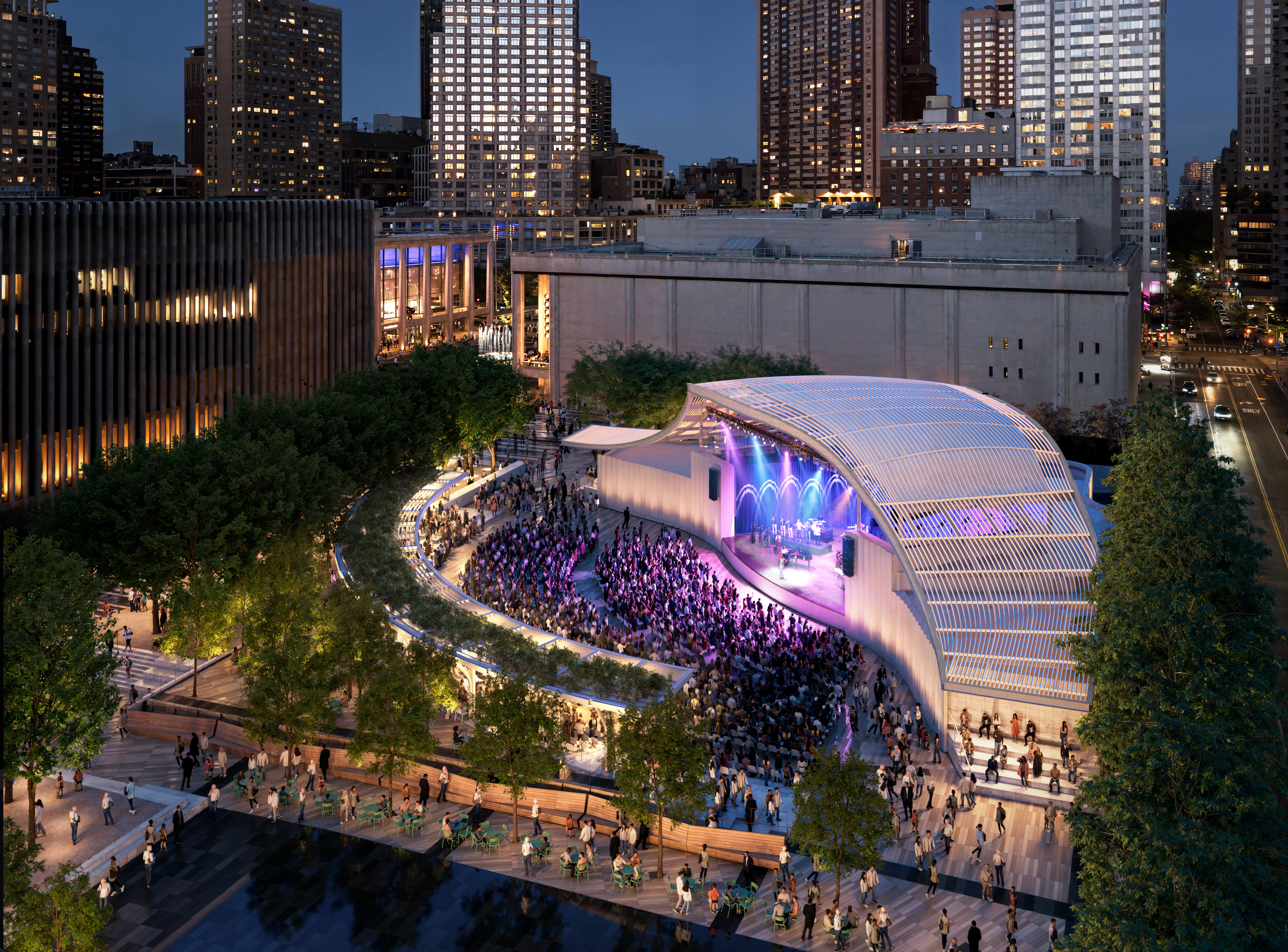
Aerial view of amphitheater and audience area during performance, looking east.
Rendering by Brooklyn Digital Foundry.
The new performance venue—which includes a permanent theater structure and an inviting, open plaza for audience seating of up to approx. 2,000—will anchor the improved, world-class performance park to meet artistic and community needs.
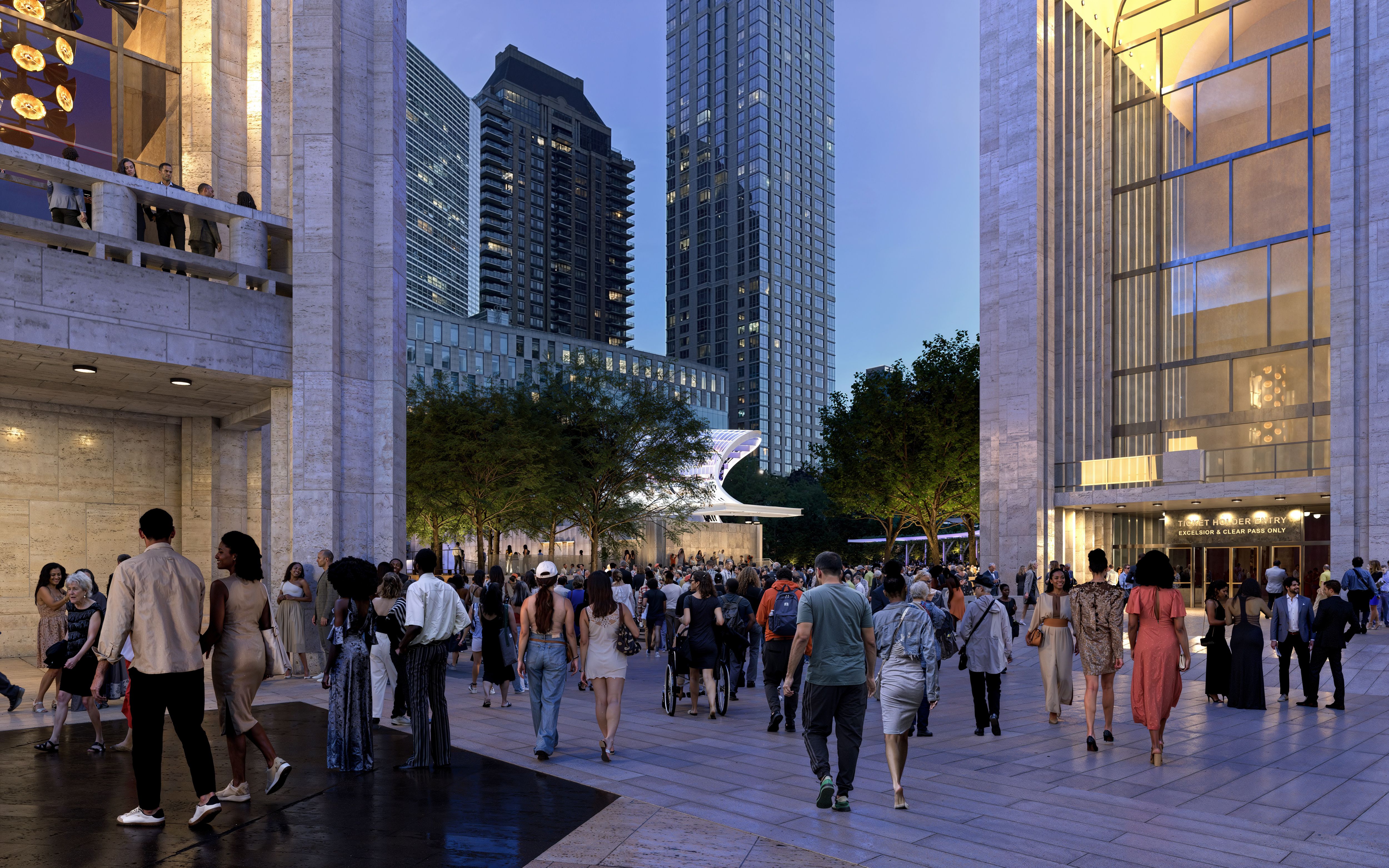
View from Josie Robertson Plaza looking towards Damrosch Park; visible are new amphitheater and landscape. Rendering by Brooklyn Digital Foundry.
The location and design of the new performance venue maintains the historic vista from Josie Robertson Plaza. The venue realizes the original intent of a theater in a park, by surrounding the new architecture with a veil of trees following the original grid design of the park.
The new size, orientation, and design of the stage, along with technological and infrastructural improvements, will greatly improve the artist and audience experience in Damrosch Park and mitigate sound impact outside the venue as it welcomes dance, theater, and music from around the world.
View of amphitheater and audience area during performance looking southeast towards 62nd Street.
Rendering by Brooklyn Digital Foundry.
In community workshops, participants emphasized the importance of maintaining the park’s primary and historic use as a performance park. Damrosch Park has been an essential space for free, non-ticket holding public access since its inception. But, for the majority of the year, the predominantly hardscaped space is cut off from the contiguous community with limited greenspace and seating. This design will allow for more of the park to be used year-round, as the permanent venue will not require significant buildouts before and after each performance season. The configuration of the stage and its seating frame a plaza that also supports a variety of events and flexible uses.
When not used for performances, the plaza area can also serve as a recreation destination.
Theater features include:
- An open plaza that is accessible to the public
- A stage and theater oriented to bring audiences closer to performances and to allow for use of the park during shows
- An Artists’ Bar, adjacent to the theater, with food and beverage during performances and non-performance seasons
- A shaded overlook and grove with tiered seating for improved sightlines during performances, and daytime activation by the community outside of the performance season
View of plaza area in front of amphitheater, looking northeast towards Josie Robertson Plaza.
Rendering by Brooklyn Digital Foundry.
A robust participatory design process
Throughout conceptualization and design, LCPA and its consultants have engaged thousands of New Yorkers through one-on-one interviews, focus groups, paper and online surveys, pop-up events, and workshops. These conversations have brought together neighbors, nearby NYCHA residents, advocates, community groups, staff and students from nearby educational institutions, elected officials, civic leaders, and other members of the New York City community, who shared their ideas, interests, questions, and feedback about the campus. This feedback shaped the design released today. Community members will continue to have opportunities to share ideas throughout the next phases of work.
This work included:
- 3,500+ survey responses, which gathered information from stakeholders, Lincoln Center audiences, and campus visitors about the wall along Amsterdam Avenue, the design of Damrosch Park, and the uses (both actual and desired) of the park and the campus' outdoor spaces
- 20+ pop-up events reaching 1,000+ people
- 5 community workshops attended by 470+ participants, in which stakeholders offered design ideas, reflections on access, and posed invaluable questions about the future of the campus
- 7 focus groups attended by 66 participants, including community stakeholders, preservation and design experts, accessibility groups, seniors, NYCHA residents, community organizations, school leadership, and members of Community Board 7
To provide broad access to each session, engagement materials were translated into Spanish and Simplified Chinese. During workshops, Spanish, Mandarin, and American Sign Language (ASL) interpreters were offered and assisted listening devices (ALDs) were made available. Engagement events were held both on weekdays and weekends, during daytime and evening hours, with childcare and refreshments made available during workshops. The next community open house will be on Thursday, May 22.
LCPA is still calling upon New Yorkers to get directly involved by offering feedback through LincolnCenter.org/series/planning-process and by participating in events on and off the Lincoln Center campus.
More about the participatory process is available here.
What we learned
In total, LCPA received feedback through more than 6,200 interactions with individuals, ensuring a broad array of stakeholders have a voice in the process.
Key takeaways that informed this design:
- Participants emphasized their desire to see a welcoming performance park and an urban oasis for everyone, which includes prioritizing the needs of the elderly, kids, and families and ensuring that the elements of the park are accessible to all.
- Participants wanted to see a versatile, multi-use stage that allows for everything from formal performances to informal performances throughout different seasons. Young people, in particular, believed that the arts should be the primary focus of the park.
- Community members felt strongly that the west side entrance should be open and welcoming, incorporating greenery and creating space for rest and reflection.
A commitment to a future that welcomes all
To honor the communities of the neighborhood, LCPA has invested in several major projects that shine a light on the important history of the area and celebrate its significant cultural impact. These include the Legacies of San Juan Hill digital hub, a platform for historians, scholars, and artists, as well as a series of events and exhibits that engage with this history from a multitude of perspectives.
The initiative also recognizes that more programming from a range of cultural traditions across Lincoln Center’s outdoor venues requires updated facilities to improve audience experience and access, which will allow the institution to continue to usher in new audiences. Among these programs is the annual Summer for the City festival, which has included hundreds of free events and thousands of artists performing across Lincoln Center’s 16-acre campus, serving over 1 million visitors since it launched in 2022.
This year, LCPA is piloting the NYCHA Neighbor Summer Pass during Summer for the City to residents living in NYCHA Amsterdam Houses and Addition and Harborview Terrace, offering priority entry through the Fast Track Line to free performances all season.
The SNF Lincoln Center West Initiative will create meaningful economic output, jobs, and earnings for New York City, both directly and indirectly. The new design is also committed to incorporating climate responsive elements, such as on-site stormwater management and updated mechanical, electrical, and plumbing systems. The landscape and architectural design will greatly improve shade and provide a cooling water feature to improve visitors’ experience in hot summers.
Additional design interventions in the concourse connecting Amsterdam Avenue to the 1 train and at the corner of 65th Street will be shared in the coming months.
A quote sheet with comments from a range of stakeholders is available here.
The design team
LCPA hired a team composed of three of the world’s premier design firms to action the learnings from the ongoing participatory process. The design reflects the extensive community feedback gathered throughout this process.
Altogether, the team brings together designers with collective decades of experience in urban design, including Hood Design Studio (Landscape Architect), WEISS/MANFREDI (Design Architect) and Moody Nolan (Architect of Record). Other consultants on the project include NADAAA (Planning Firm), Thornton Tomasetti (Structural Engineer), Siteworks (Landscape Architect of Record), Theatre Projects Consultants (Theater Consultant), Jaffe Holden Acoustics (Acousticians/AV), Legacy Engineers (Mechanical Engineer), JBB (Electrical Engineer), Sherwood Design Engineers (Civil Engineer), and Turner Construction Company (Pre-Construction Manager).
Imagery may be accessed here.
***
About Hood Design Studio
Hood Design Studio, Inc. is a social art and design practice based in Oakland, California, founded in 1992. The studio’s practice is tripartite: art + fabrication, design + landscape, and research + urbanism. This breadth allows us to understand each place in its scale and context. They respond not with a standard design, but with an approach adaptive to the particulars and specifics of a space. They strengthen endemic patterns and practices—those ecological and cultural, contemporary and historic, and those that remain unseen or unrecognized. Urban spaces and their objects act as public sculpture, creating new apertures through which to see the emergent beauty, strangeness, and idiosyncrasies around us.
About WEISS/MANFREDI Architecture/Landscape/Urbanism
WEISS/MANFREDI Architecture/Landscape/Urbanism is a New York City-based multidisciplinary practice known for the dynamic integration of architecture, art, infrastructure, and landscape. Founded by Marion Weiss and Michael A. Manfredi, notable projects include Seattle’s Olympic Sculpture Park, the Women’s Memorial at Arlington Cemetery, Hunter’s Point South Waterfront Park, the Brooklyn Botanic Garden Visitor Center, and the reimagining of Longwood Gardens, Pennsylvania. Current work includes the US Embassy in New Delhi, India, La Brea Tar Pits in Los Angeles, and the expansion of the Nelson Atkins Museum of Art in Kansas City, MO. The firm has been recognized with the 2024 Louis I. Kahn Award, the 2020 Thomas Jefferson Foundation Medal, the Architectural League’s Emerging Voices award, and the Cooper Hewitt National Design Award for Architecture.
About Moody Nolan
Moody Nolan is the country’s largest African American-owned and managed design firm. Founded in 1982 with just two employees in Columbus, OH, Moody Nolan has grown to more than 330 employees in 12 locations around the country, leveraging the power of diverse backgrounds to drive design innovation. With expertise spanning cultural and civic work—alongside a diverse portfolio in other sectors, Moody Nolan is guided by its mission to improve every life the firm touches through responsive design—pairing empathetic listening with innovative thinkingto find harmony between client, community, and environment. Acknowledging the firm’s sustained professional excellence, The American Institute of Architects (AIA) named Moody Nolan as the 58th recipient of the Architecture Firm Award in 2021, the highest honor the AIA bestows on an architecture practice. In 2022, the firm celebrated its 40th anniversary and was also named one of the most innovative architecture firms by Fast Company.
About the Stavros Niarchos Foundation (SNF)
The Stavros Niarchos Foundation (SNF) is one of the world’s leading private, international philanthropic organizations, making grants to nonprofit organizations in the areas of arts and culture, education, health and sports, and social welfare. SNF supports organizations and projects worldwide that aim to achieve a broad, lasting, and positive impact for society at large and exhibit strong leadership and sound management. The Foundation also supports projects that facilitate the formation of public-private partnerships as an effective means for serving public welfare.
Since 1996, the Foundation has committed more than $3.8 billion through over 5,500 grants to nonprofit organizations in more than 130 countries around the world.
About The Starr Foundation
The Starr Foundation was established in 1955 by Cornelius Vander Starr, a global entrepreneur, humanitarian, and citizen of the world. Mr. Starr’s distinctive approach to giving set the stage for impact-driven philanthropy, stewarded forward across generations by longtime Foundation Chair Maurice R. (“Hank”) Greenberg. Today, these visionary leaders’ legacies endure in the positive change and lasting impact The Starr Foundation fosters around the world. The Foundation awarded more than $4.1 billion to 2,315 organizations addressing society’s most pressing challenges.
The Starr Foundation believes philanthropy is about building partnerships, creating opportunities, sustaining collaborations, and investing in the future. It supports organizations with strong leadership and the capacity to address complex challenges with durable results, including advancing medical research, improving access to education, upgrading delivery of basic social services, or fostering mutual understanding across cultures and fields. The Foundation’s purview is both local—it is deeply invested in New York City—and global.
***
FOLLOW LINCOLN CENTER ON SOCIAL MEDIA:
Facebook: facebook.com/LincolnCenter
X/Twitter: @LincolnCenter
Instagram: @LincolnCenter
TikTok: @LincolnCenter
Threads: @LincolnCenter
#LincolnCenter
###
For more information, please contact:
Isabel Sinistore
[email protected]
212-671-4195
Jenni Klauder
[email protected]
212-875-5490
BerlinRosen
l[email protected]
